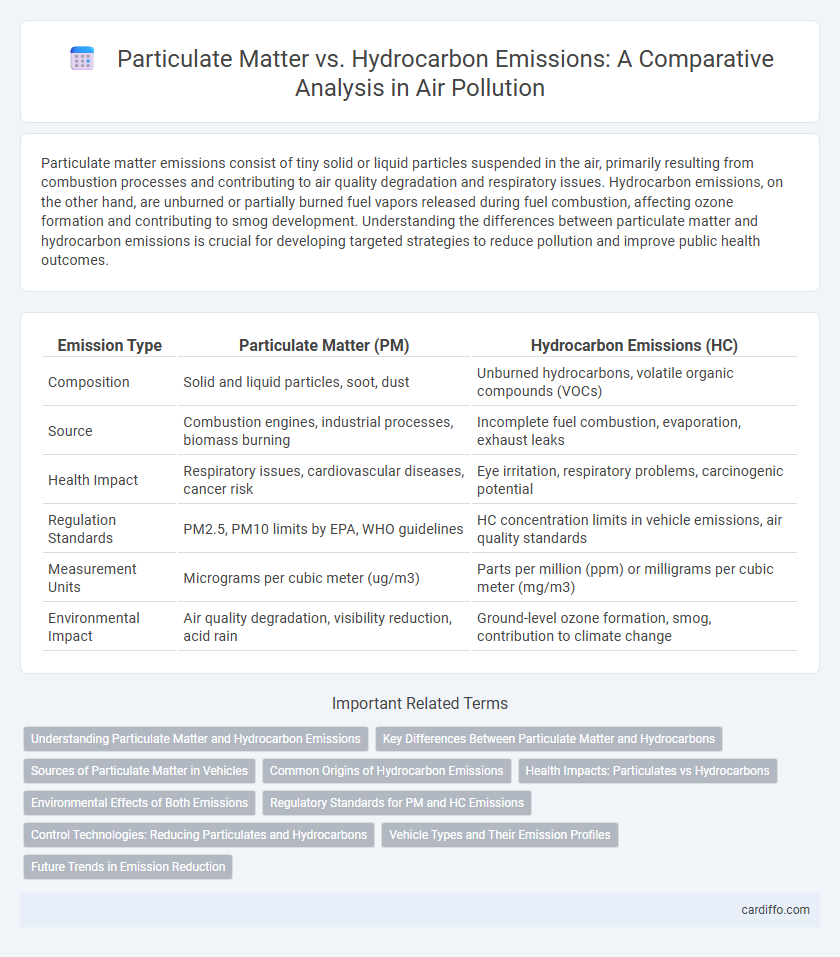Particulate matter emissions consist of tiny solid or liquid particles suspended in the air, primarily resulting from combustion processes and contributing to air quality degradation and respiratory issues. Hydrocarbon emissions, on the other hand, are unburned or partially burned fuel vapors released during fuel combustion, affecting ozone formation and contributing to smog development. Understanding the differences between particulate matter and hydrocarbon emissions is crucial for developing targeted strategies to reduce pollution and improve public health outcomes.
Table of Comparison
| Emission Type | Particulate Matter (PM) | Hydrocarbon Emissions (HC) |
|---|---|---|
| Composition | Solid and liquid particles, soot, dust | Unburned hydrocarbons, volatile organic compounds (VOCs) |
| Source | Combustion engines, industrial processes, biomass burning | Incomplete fuel combustion, evaporation, exhaust leaks |
| Health Impact | Respiratory issues, cardiovascular diseases, cancer risk | Eye irritation, respiratory problems, carcinogenic potential |
| Regulation Standards | PM2.5, PM10 limits by EPA, WHO guidelines | HC concentration limits in vehicle emissions, air quality standards |
| Measurement Units | Micrograms per cubic meter (ug/m3) | Parts per million (ppm) or milligrams per cubic meter (mg/m3) |
| Environmental Impact | Air quality degradation, visibility reduction, acid rain | Ground-level ozone formation, smog, contribution to climate change |
Understanding Particulate Matter and Hydrocarbon Emissions
Particulate matter emissions consist of tiny solid particles and liquid droplets that can penetrate the respiratory system, causing health risks and environmental damage. Hydrocarbon emissions are unburned fuel components released during combustion, contributing significantly to smog formation and ground-level ozone. Understanding the sources and impacts of both emissions is crucial for developing effective pollution control strategies and improving air quality.
Key Differences Between Particulate Matter and Hydrocarbons
Particulate matter (PM) emissions consist of tiny solid or liquid particles suspended in the air, primarily from combustion processes, while hydrocarbon emissions are unburned or partially burned organic compounds released as gases. PM contributes significantly to respiratory and cardiovascular diseases due to its ability to penetrate deep into the lungs, whereas hydrocarbons play a major role in the formation of ground-level ozone and smog, impacting air quality and human health. Key differences include their physical state, sources, health effects, and roles in atmospheric chemical reactions.
Sources of Particulate Matter in Vehicles
Particulate matter emissions in vehicles primarily originate from incomplete combustion of fuel, especially in diesel engines, where soot and ash particles are released. Hydrocarbon emissions stem from unburned or partially burned fuel vapors during the combustion process, fuel evaporation, and exhaust leaks. Diesel engines produce higher particulate matter due to high-pressure injection and lower combustion temperatures, while hydrocarbon emissions are more prominent in gasoline engines with rich fuel mixtures.
Common Origins of Hydrocarbon Emissions
Particulate matter and hydrocarbon emissions primarily originate from incomplete combustion processes in engines and industrial activities. Hydrocarbon emissions commonly arise from unburned fuel vapor, evaporation losses, and leakages in the fuel system. Both emission types contribute significantly to air pollution, but hydrocarbons are specifically linked to volatile organic compounds that contribute to ground-level ozone formation.
Health Impacts: Particulates vs Hydrocarbons
Particulate matter (PM) emissions penetrate deep into the respiratory system, causing chronic bronchitis, asthma, and cardiovascular diseases due to their ability to carry toxic metals and organic compounds. Hydrocarbon emissions, primarily volatile organic compounds (VOCs), contribute to the formation of ground-level ozone and secondary organic aerosols, aggravating respiratory conditions and increasing the risk of lung cancer. Both pollutants significantly undermine air quality and public health, with particulates presenting acute physical risks and hydrocarbons promoting long-term chemical exposure hazards.
Environmental Effects of Both Emissions
Particulate matter emissions contribute significantly to air pollution, causing respiratory and cardiovascular diseases due to fine particles penetrating deep into the lungs and bloodstream. Hydrocarbon emissions, primarily from incomplete combustion, lead to ground-level ozone formation and photochemical smog, which harm plant life and reduce air quality. Both emissions degrade ecosystems, with particulates depositing toxic metals in soil and hydrocarbons disrupting photosynthesis and biodiversity.
Regulatory Standards for PM and HC Emissions
Regulatory standards for particulate matter (PM) and hydrocarbon (HC) emissions vary significantly across regions, with the Environmental Protection Agency (EPA) enforcing stringent PM limits of 0.01 grams per mile for light-duty vehicles under Tier 3 standards. Hydrocarbon emissions are controlled through limits such as the Euro 6 standard, which restricts non-methane hydrocarbons (NMHC) to 0.068 grams per kilometer. Compliance with these standards requires advanced emission control technologies like diesel particulate filters (DPFs) for PM and catalytic converters targeting HC reduction.
Control Technologies: Reducing Particulates and Hydrocarbons
Particulate matter (PM) emissions are effectively reduced using technologies such as diesel particulate filters (DPFs) and electrostatic precipitators, which capture fine particles before release. Hydrocarbon (HC) emissions are minimized through catalytic converters and advanced fuel injection systems that promote more complete combustion. Combining these control technologies enhances overall air quality by targeting both solid particulates and gaseous hydrocarbons simultaneously.
Vehicle Types and Their Emission Profiles
Diesel vehicles primarily emit higher levels of particulate matter (PM) due to incomplete combustion of heavier fuel components, resulting in soot and fine particles that pose significant health risks. Gasoline vehicles tend to produce more hydrocarbon (HC) emissions, especially during cold starts and incomplete fuel vapor combustion, contributing to smog formation and ground-level ozone. Hybrid and electric vehicles exhibit significantly lower particulate matter and hydrocarbon emissions, highlighting their potential to reduce urban air pollution and improve air quality.
Future Trends in Emission Reduction
Particulate matter emissions are expected to decline sharply due to advancements in filtration technologies and stricter regulatory standards targeting fine and ultrafine particles. Hydrocarbon emissions will increasingly be mitigated through the adoption of cleaner fuels and enhanced combustion efficiency in engines, supported by the growing integration of electric and hybrid powertrains. Future trends emphasize the synergy of innovative catalytic converters and real-time emission monitoring systems to achieve comprehensive reductions across both particulate and hydrocarbon pollutants.
Particulate matter vs Hydrocarbon emissions Infographic

 cardiffo.com
cardiffo.com